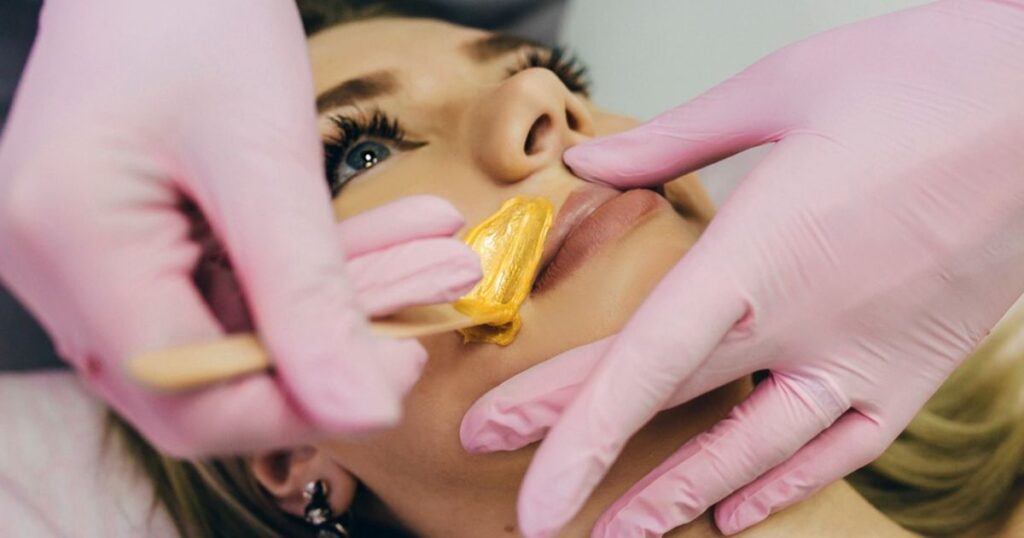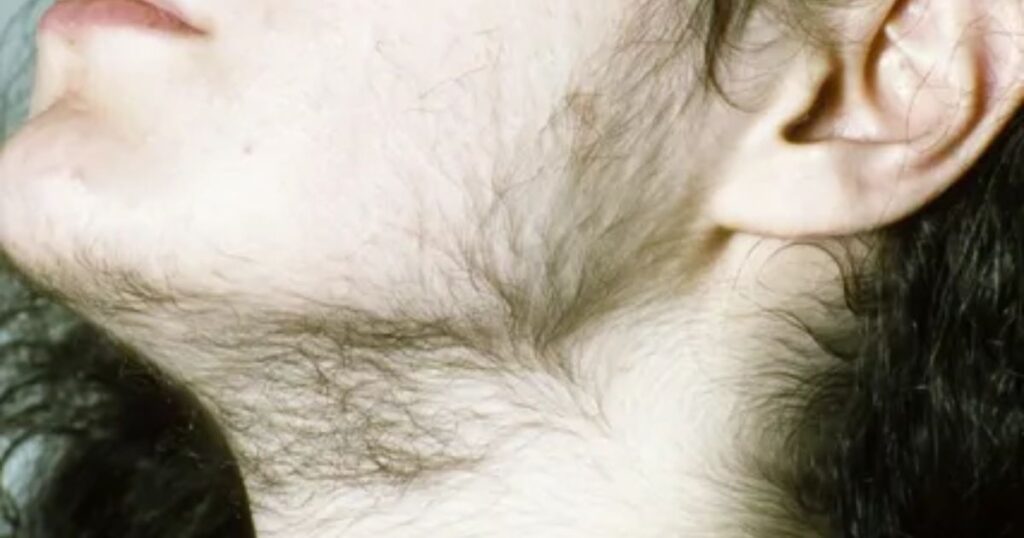Unwanted chin hair, often referred to as hirsutism, is a condition where women experience excessive and coarse hair growth on their chin and other facial areas. While some degree of facial hair is normal, hirsutism goes beyond the typical and can lead to emotional distress and lowered self-esteem.
Have you ever found yourself wondering, What causes female hair growth on the chin? It’s a common question that many individuals, especially women, seek answers to. In this article, we’ll delve into the intriguing world of female facial hair, exploring the various factors contributing to the development of hair on the chin.
The causes of female hair growth on the chin are diverse and often interconnected. Genetics plays a significant role in determining an individual’s susceptibility to excessive facial hair. Hormonal imbalances, such as elevated androgen levels, can trigger the growth of coarse hair on the chin.
Hormonal imbalances and their impact on facial hair growth
The imbalances directly affect how facial hair grows. When hormones, especially androgens, are out of balance, it can lead to an increase in the growth of hair on the face, including the chin. These imbalances signal the hair follicles to produce thicker and more noticeable hair, causing unwanted facial hair in women.
To manage hormonal imbalances and their impact on facial hair growth, it’s crucial to address the root cause. Lifestyle changes, such as maintaining a healthy diet and managing stress, can play a significant role. Seeking guidance from healthcare professionals to explore hormone-regulating medications or treatments tailored to individual needs is essential for effectively addressing and reducing unwanted chin hair growth.
Polycystic Ovary Syndrome (PCOS)
Polycystic Ovary Syndrome (PCOS) is a common hormonal disorder in women, that affects the ovaries’ normal functioning. It often leads to irregular periods and the development of small cysts on the ovaries. PCOS is linked to an overproduction of androgens, the male hormones, which can result in symptoms like facial hair growth, including the chin.
Women with PCOS notice increased hair growth on their chin, a condition known as hirsutism. This occurs due to the elevated levels of androgens stimulating hair follicles in unusual areas. Understanding PCOS and its impact on hormonal balance is crucial for those experiencing unwanted chin hair, as it helps in exploring effective management strategies and seeking timely medical advice.
The link between PCOS and excess hair growth
Polycystic Ovary Syndrome (PCOS) is a common condition among women, that impacts their hormonal balance. One noticeable effect is the excess growth of hair, particularly on the face. PCOS stimulates the production of androgens, male hormones, leading to the development of unwanted facial hair, such as on the chin. Understanding this link is crucial for women with PCOS, empowering them to address and manage this specific symptom through targeted treatments and lifestyle adjustments.
In PCOS, the elevated androgens not only disrupt the normal menstrual cycle but also trigger hirsutism, the medical term for excessive hair growth. This connection between PCOS and facial hair growth is a direct result of hormonal imbalances. By acknowledging and comprehending this link, women with PCOS can work with healthcare professionals to develop personalized strategies for managing and reducing the impact of excess hair growth on their chin and other facial areas.
Effect of menopausal hormonal shifts on facial hair
Menopausal hormonal changes impact facial hair growth. As estrogen levels decrease, androgens become relatively more dominant, leading to the emergence of chin hair in women. Hormonal shifts during menopause contribute directly to the development of unwanted facial hair.
These changes affect the hair follicles, making them more susceptible to androgen stimulation. The result is the growth of coarse hair on the chin. Understanding this hormonal dynamic is crucial for women navigating menopause and dealing with the unexpected challenge of facial hair.
Adrenal Gland Disorders
Adrenal gland disorders, like Cushing’s syndrome, can disrupt hormonal balance and lead to the growth of unwanted facial hair, specifically on the chin. These disorders overstimulate the adrenal glands, causing an excess production of cortisol. This surge in cortisol levels can trigger the growth of coarse hair, presenting a unique challenge for those dealing with unwanted chin hair.
Understanding the link between adrenal gland disorders and chin hair growth is vital for those seeking solutions. Seeking medical advice becomes crucial in managing these conditions effectively. Dermatologists and endocrinologists can provide tailored guidance and treatments to address the hormonal imbalances contributing to the development of unwanted facial hair, helping individuals regain confidence and control over their appearance.
The connection between adrenal issues and unwanted chin hair
Unwanted chin hair can be linked to adrenal issues. The adrenal glands, responsible for hormone production, cause imbalances, leading to excess facial hair. When these glands act up, they can disrupt the delicate hormonal harmony in women, potentially resulting in the development of unwanted hair on the chin.
Adrenal problems, if left unchecked, can contribute to hormonal fluctuations. These fluctuations, particularly an increase in androgens, stimulate the growth of coarse hair on the chin. Understanding and addressing adrenal issues becomes crucial in managing and preventing the occurrence of unwanted facial hair in women.
Foods that may contribute to or inhibit facial hair growth
Unwanted facial hair can be influenced by the foods we eat. Some foods, like those high in refined sugars and carbohydrates, may contribute to increased hair growth on the face. On the other hand, a diet rich in vitamins and minerals, such as fruits and vegetables, can potentially inhibit facial hair growth. It’s essential to be mindful of our dietary choices, as they play a role in maintaining hormonal balance and, consequently, affecting the growth of facial hair.
When aiming to reduce facial hair growth, consider incorporating foods like spinach, broccoli, and berries into your diet. These foods are packed with antioxidants and nutrients that support hormonal equilibrium. On the flip side, minimizing the intake of sugary snacks and processed foods helps curb excessive facial hair. A balanced and nutritious diet not only benefits overall health but also plays a role in managing unwanted facial hair effectively.
Hair Removal Methods

There are various methods for removing unwanted hair. Shaving is quick but needs frequent upkeep. Waxing pulls hair from the root for longer-lasting results. Laser hair removal offers permanent reduction, targeting hair follicles with light energy.
- Shaving for Quick Results: Shaving offers a speedy and cost-effective solution for hair removal. While it provides instant smoothness, be mindful of the quick regrowth and potential skin irritation.
- Waxing: Lasting Smoothness, but With Caution: Waxing delivers longer-lasting results by removing hair from the root. It can be painful and may cause skin irritation, requiring careful consideration.
- Laser Hair Removal: Laser hair removal targets hair follicles, offering precision and semi-permanent results. It’s effective, but factors like skin type and cost should be considered before opting for this method.
- Epilation: Minimize Maintenance, Tackle Pain: Epilation provides longer-lasting smoothness, but the process can be uncomfortable. Consider this method if you prefer less frequent maintenance and are comfortable with potential mild discomfort.
Overview of various hair removal techniques
When it comes to saying goodbye to unwanted facial hair, there’s no one-size-fits-all solution. Many techniques are available, each with its pros and cons. Waxing, a popular choice, removes hair from the root, providing longer-lasting smoothness. Shaving, on the other hand, is quick and convenient but requires more frequent upkeep.
Laser hair removal is a noteworthy choice for managing concerns like a receding hairline in women. This semi-permanent solution precisely targets hair follicles, minimizing regrowth over time. Optimal results are achieved through multiple sessions. By comprehending these diverse techniques, individuals gain the knowledge to select the approach that best aligns with their preferences and lifestyles, addressing concerns like a receding hairline in women effectively.
Pros and cons of each method
Hair removal methods come with their own set of pros and cons. Waxing provides longer smoothness but can be painful. Shaving is quick but needs frequent attention. Laser removal offers semi-permanence but requires multiple sessions. Choose wisely based on your preferences and lifestyle.
| Hair Removal Method | Pros | Cons |
| Shaving | – Quick and easy<br>- Inexpensive | – Hair grows back quickly<br>- Potential for razor burn and ingrown hairs |
| Waxing | – Longer-lasting results<br>- Hair may grow back finer | – Can be painful<br>- Possible skin irritation and redness |
| Laser Hair Removal | – Permanent reduction over time<br>- Precision targeting | – Expensive<br>- Not suitable for all skin and hair types |
| Epilation | – Longer-lasting than shaving<br>- Less frequent maintenance | – Can be painful<br>- cause skin irritation |
| Depilatory Creams | – Quick and painless<br>- Inexpensive | – Strong chemical smell<br>- Potential for skin irritation |
| Electrolysis | – Permanent hair removal<br>- Suitable for small areas | – Time-consuming<br>- Can be expensive |
Understanding the pros and cons of each hair removal method is essential for choosing the one that best fits your preferences and needs. Evaluate factors like pain tolerance, budget, and desired duration of results to make an informed decision.
Natural Remedies
Natural remedies offer effective ways to address this common concern without resorting to harsh chemicals. Simple practices like turmeric masks and spearmint tea can help regulate hormones, slowing down the growth of facial hair.
Ditching the razor and opting for sugar wax, a natural hair removal alternative, is another practical approach. These remedies not only tackle the symptoms but also promote overall skin health. Embrace the power of nature in your skincare routine and say goodbye to unwanted chin hair the natural way.
FAQs
how to stop hair growth on a woman’s face?
To inhibit facial hair, consider methods like waxing or laser hair removal. These procedures help manage unwanted hair growth effectively for a smoother complexion.
Does rice water increase facial hair for females?
No, rice water does not increase facial hair in females. It’s a popular natural treatment for hair care, promoting shine and strength without causing unwanted hair growth.
How do I balance my hormones to stop facial hair?
Balancing hormones involves a healthy diet, regular exercise, and stress management. Consult with a healthcare professional to explore tailored solutions for hormonal balance and reduced facial hair growth.
Why is my chin hair suddenly growing female?
Sudden chin hair growth in females results from factors like hormonal changes, genetics, or medication side effects. Consult with a healthcare provider to identify the root cause and explore suitable solutions
Conclusion
Understanding what causes female hair growth on the chin is crucial for finding effective solutions. From genetic factors to hormonal imbalances, various reasons contribute to this common concern. Embracing natural remedies, exploring professional help, and making lifestyle adjustments empower women to manage unwanted facial hair.
You’re not alone in this journey. By addressing the root causes and adopting suitable strategies, you can regain confidence and maintain smooth, radiant skin. Take charge, and discover the methods that work best for you.


Pingback: what age does women's hair go grey?